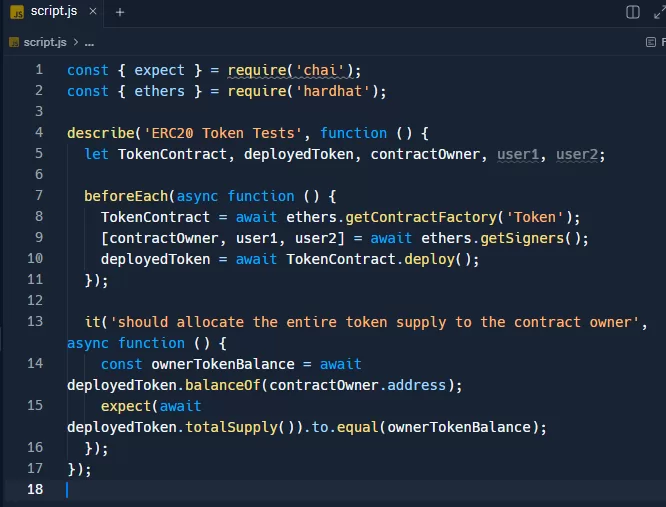Company
Contact
5900 Balcones Drive
#22258 Austin, TX, USA
Subscribe
Follow our newsletter to stay updated about us.
2025-Aishco Solutions & Consultancy. All Rights Reserved.
Share post on
Writing automated tests for Ethereum smart contracts is crucial for ensuring their reliability and security in blockchain technology and decentralized applications (dApps). These self-executing agreements on the blockchain have revolutionized industries by enabling trustless, transparent transactions. However, the immutability of smart contracts once deployed means that even the smallest error can have significant consequences. This is why writing automated tests for Ethereum smart contracts has become a necessity for developers.
The information provided in this blog is for educational purposes only and should not be considered as legal or financial advice. Please consult with a qualified professional or your local regulations regarding Ethereum and related activities before proceeding with any development or transactions.
Before diving into writing automated tests for Ethereum, it’s important to understand what Ethereum smart contracts are and why they need testing. Ethereum smart contracts are programs written in Solidity, Ethereum’s native programming language, that automatically execute predefined actions when specific conditions are met. Once deployed on the Ethereum blockchain, these contracts are immutable, making thorough pre-deployment testing crucial.
Smart contracts power a wide range of decentralized applications (dApps), such as decentralized finance (DeFi) and NFTs, facilitating transactions without intermediaries. However, their unchangeable nature makes them vulnerable to coding errors and security exploits, which is why testing is essential to ensure proper functionality and security.
Smart contract failures on Ethereum can lead to significant consequences, including financial losses. High-profile incidents like the DAO hack highlight the dangers of deploying faulty contracts.
Example: Consider a decentralized lending platform running on Ethereum. If the smart contract governing loan repayments has a bug, users could potentially exploit it to avoid repaying their loans. Automated testing can catch such issues before the contract is deployed, avoiding the potential loss of millions of dollars.
Automated testing allows developers to simulate various conditions and scenarios to verify how the contract behaves. This helps in detecting issues early, even in well-written contracts that may interact unpredictably with external data feeds or other contracts.
By running tests, developers can identify vulnerabilities and ensure that smart contracts are secure before they go live, reducing the risk of costly errors.
Real-world case: During the launch of a DeFi protocol, automated security tests revealed vulnerabilities in the staking function, preventing a potential security breach that could have drained funds from the contract.
Automated testing accelerates the development process by removing the need for manual testing. This ensures consistency and saves time by automating repetitive tasks, allowing for smoother test runs.
To begin testing Ethereum, you need to set up a development environment that allows you to develop, compile, and test your smart contracts. Here’s a list of essential tools for this process
| Tool | Description |
|---|---|
| Node.js | Required to manage dependencies and run JavaScript-based testing frameworks. |
| Solidity Compiler | Translates Solidity code into bytecode that can be deployed on the blockchain. |
| Truffle | A popular framework for Ethereum development that simplifies managing contracts and testing. |
| Hardhat | A powerful development tool focusing on flexibility and control, ideal for testing smart contracts. |
| Ganache | A local blockchain emulator that allows deploying contracts and running tests without gas fees. |
By setting up these tools, you create a robust environment for developing and writing tests for Ethereum smart contracts
Several testing frameworks are available to help developers test Ethereum smart contracts. Here are some of the most widely used ones:
In addition to being a powerful development framework, Truffle includes built-in testing support, allowing developers to easily write and run tests for Ethereum smart contracts.
Usage: Truffle supports both Solidity and JavaScript-based testing, offering flexibility to developers depending on their preference.
Unit testing is a fundamental aspect of writing automated tests for Ethereum. It involves testing individual components or functions of a smart contract in isolation to ensure they work correctly. Unit tests are typically written for critical functions within a smart contract, such as transferring tokens, checking balances, or executing specific logic
Steps to follow for writing unit tests:
Here’s an example of writing automated tests for Ethereum using Hardhat:

When writing automated tests for Ethereum, it’s important to go beyond basic unit testing and adopt advanced strategies for thorough testing. Here are some advanced strategies:
Fuzz testing involves inputting random data into the smart contract to check for unexpected behaviors or crashes. This approach helps uncover edge cases that might not be apparent during regular testing.
Example: Fuzz testing a token transfer function by inputting values larger than the total supply can reveal how the contract handles such inputs.
Ethereum smart contracts require gas to execute. Testing the gas usage of various functions helps optimize performance and ensures that the contract doesn’t consume excessive gas, making it prohibitively expensive to use
Stress testing involves simulating large numbers of transactions to see how the contract performs under heavy load. This helps ensure that the contract can handle high traffic volumes without failing.
To start:
Install Hardhat in your project using npm.

Set up the testing environment.
Use Mocha and Chai to write test cases for your smart contracts.
A security analysis tool that scans smart contracts for vulnerabilities
A static analysis tool that checks Solidity code for common vulnerabilities
To ensure success when writing tests for Ethereum, developers should follow these best practices:
Writing tests that handle extreme or unexpected scenarios ensures the contract’s robustness.
Well-structured tests make it easier for teams to understand and maintain the code.
Share post on
Company
Contact
5900 Balcones Drive
#22258 Austin, TX, USA
Subscribe
Follow our newsletter to stay updated about us.
2025-Aishco Solutions & Consultancy. All Rights Reserved.
